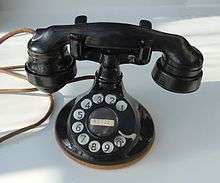Model 102 telephone

The model 102 telephone was a version of Western Electric's first widely distributed telephone set that featured the transmitter and receiver in a common handset. Although this type designation was not used before ca. 1930, predecessor types were produced starting approximately in 1927 with the A handset mounting. Earlier telephones by Western Electric had been of the candlestick type which featured a transmitter fixed to the base, and a receiver held by the user to the ear. The design of the A handset mounting was inherited from the candlestick desk stands, while the B handset mounting was slightly reshaped. The B type was produced between 1928 and 1932. Later models, the D handset mounting, starting in 1930, used an oval foot print to improve physical stability during dialing.
The model 102 telephone consisted of the handset mounting typically placed on the desk top and a physically separate desk set box or subscriber set. This box was typically mounted on a wall near the phone or on the side of a desk. The desk set contained only the dial, a handset cradle with hook switch, and the handset positioned in the cradle, while the subscriber set contained the ringer and the electrical components to interface the unit with the telephone network.
The 102 telephone was plagued by problems with excessive sidetone, resulting in a poor experience for users hearing their own voice very loudly, and in extreme cases in early versions also unstable feedback from the receiver into the transmitter. This resulted in users lowering their voice to the point where the other party found them difficult to hear. This problem was resolved when the 102 was upgraded in approximately 1930 to the 202 telephone.
History
As early as 1890, Western Electric had been experimenting with handset types that combined the transmitter and the receiver in the same hand-held unit, but two technical problems prevented them from reaching production at that time. First, the transmitters of the day did not work well unless oriented in a vertical plane. If operated at other angles, as would be expected in a hand-held unit, carbon granules in the transmitter would shift and move in an unacceptable manner, resulting in poor voice quality,[1] referred to as carbon noise.
Another hurdle to the acceptance of a common handset model was that audio from the receiver was picked up acoustically by the transmitter and amplified, resulting in howling tones, called acoustic feedback, due to the hollow handles providing an acoustic channel between receiver and transmitter. The problems were aggravated by the signal boosting circuitry used in the subscriber set which resulted in a strong signal (sidetone) at the receiver of the speech of the user.[2] Sidetone is desirable only to some fraction of volume so that the user has the assurance that the telephone is working correctly. Strong sidetone may cause users to lower the voice to unacceptable levels, so that the recipient receives insufficient signal level.
In the 1920s, developments in anti-sidetone circuitry and non-positional transmitters, which worked in any orientation, permitted Western Electric to develop a handset model free of these problems. The resulting E1 handset was ready for production in 1927. This handset was paired with a base that was essentially a candlestick with a shortened neck of approximately one inch in height, topped with a new cradle for the handset. The cradle incorporated the hookswitch as a vertical plunger actuating the electrical switch contacts. This initial design was tested in the central offices and released in limited supply as Western Electric's first handset subscriber telephone, the model A1.
Although the E1 handset was built to complement the anti-sidetone circuitry, such circuitry was still not ready by the time the A-type desk set was released. However, the solid Bakelite construction of the handset suppressed acoustic feedback to acceptable levels.[3]
As work continued on the anti-sidetone circuitry, a new base was designed for the E1 handset to replace the shortened candlestick. The new mount was designated by the part number B1, and was similar in overall shape to the A-base, but with more flowing lines and a shell cast completely in aluminum or metal alloy. This is the combination that is most commonly associated with the designation 102. During the model's production life, however, it was just referred to by its component parts.
The B-type desk set was followed by a wall-mounted handset telephone, designated as the C-type hangup telephone, with the E1 handset hanging on one side of the unit in a cradle for the receiver end.
In use, the B-type telephone base proved unstable during dialing, and was replaced with the D-type handset mounting in 1930. A wider, oval base improved its stability. While the D1 mounting base was initially deployed electrically identical to the prior models, advances in the anti-sidetone audio circuitry soon reached production quality, so that D1 sets are most commonly identified as the 202-type telephone. The assembly codes 102 and 202 referred whence to the electrical capabilities of the sets, the 102 having no sidetone reduction, and the 202 containing the anti-sidetone improvements. Thus, some of the early oval D mounts, would still be designated as model 102 if they did not yet have the anti-sidetone circuitry.[4]
See also
References
- ↑ Mountjoy, Richard (1995). 100 Years of Bell Telephones. Schiffer Publishing. p. 138. ISBN 0-88740-872-9.
- ↑ Meyer, Ralph O. (2005). Old Time Telephones! Design, History, and Restoration. Schiffer Publishing. p. 63. ISBN 0-7643-2282-6.
- ↑ Meyer, Ralph O. (2005). Old Time Telephones! Design, History, and Restoration. Schiffer Publishing. p. 64. ISBN 0-7643-2282-6.
- ↑ Meyer, Ralph O. (2005). Old Time Telephones! Design, History, and Restoration. Schiffer Publishing. p. 65. ISBN 0-7643-2282-6.
External links
- Western Electric Telephone Models — A look at the evolution of the Western Electric's dial telephones